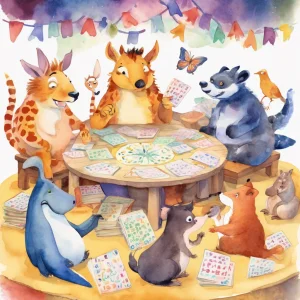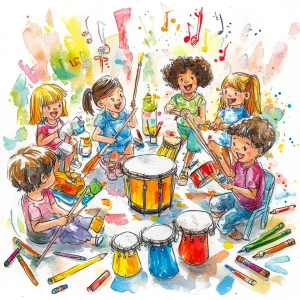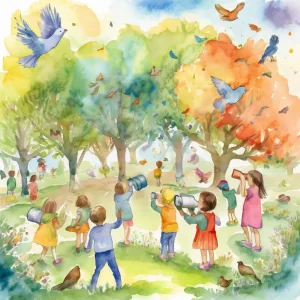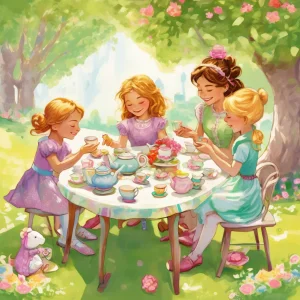Activity
Similar Activities
Musical Painting Fun: Expressive Art and Melodies
Children’s Age: 2–3 years
Activity Duration: 10 – 30 minutes
This activity involves children creating paintings while listening to music that matches the mood of sentences they choose. It helps with sensory development, and social-emotional …
Activity Duration: 10 – 30 minutes
Magical Math Journey: Sensory Math Storytime Adventure
Children’s Age: 2–3 years
Activity Duration: 10 – 30 minutes
Let's embark on the "Sensory Math Storytime" adventure! This activity blends sensory exploration, storytelling, and basic math to make learning engaging for children. You'll need t…
Activity Duration: 10 – 30 minutes
Sensory Treasure Hunt: A Magical Exploration Journey
Children’s Age: 0 month – 6 years
Activity Duration: 10 minutes
Let's go on a Sensory Treasure Hunt! We will use our senses to explore different items like textures, scents, and sounds. You can feel, smell, and listen to each item while blindfo…
Activity Duration: 10 minutes
Unity Blossoms: Family Handprint Tree
Children’s Age: 0 month – 6 years
Activity Duration: 10 minutes
Let's create a special "Family Handprint Tree" together! This fun activity brings families closer and helps kids grow in many ways. You'll need paper, colorful paints, brushes, wet…
Activity Duration: 10 minutes
Sensory Exploration Journey: Household Items Adventure
Children’s Age: 0 month – 6 years
Activity Duration: 10 minutes
Let's explore different textures and shapes using household items! Find a big container and items like a wooden spoon, silk scarf, plastic cup, sponge, and cotton ball. Sit togethe…
Activity Duration: 10 minutes
Sensory Texture Hunt for Developing Skills
Children’s Age: 4–7 years
Activity Duration: 5 – 10 minutes
Let's go on a Sensory Treasure Hunt! We will explore different textures like smooth stones, soft feathers, and rough sandpaper. You can use blindfolds for an extra challenge if you…
Activity Duration: 5 – 10 minutes
Empathy Through Storytelling: Musical Sensory Experience
Children’s Age: 2–3 years
Activity Duration: 5 – 15 minutes
Let's dive into Musical Sensory Storytime! Get ready for a fun experience that will engage all your senses. We will read a story, play musical instruments, create art, and enjoy co…
Activity Duration: 5 – 15 minutes
Sensory Treasure Basket Exploration: A Magical Journey
Children’s Age: 6 months – 1.5 years
Activity Duration: 10 minutes
Engage your little one with the Sensory Treasure Basket Exploration activity designed for children aged 6 to 18 months. This stimulating play experience supports sensory and cognit…
Activity Duration: 10 minutes
Enchanted Nature Discovery: Sensory Nature Exploration
Children’s Age: 1.5–2 years
Activity Duration: 10 – 15 minutes
Engage your 12 to 18-month-old in the Sensory Nature Exploration activity, fostering their sensory development through natural exploration. Set up a sensory bin with sand or water,…
Activity Duration: 10 – 15 minutes
Nature Shapes Adventure: Bird Watch & Scavenger Hunt
Children’s Age: 4–5 years
Activity Duration: 10 minutes
An outdoor activity for children aged 4-5 years combining bird watching and shape recognition.
Activity Duration: 10 minutes
Enchanted Tea Party Adventure: A Magical Journey
Children’s Age: 3 years
Activity Duration: 10 – 15 minutes
Join us for a Magical Tea Party Adventure! Enhance your child's play skills, social-emotional growth, and language abilities through a whimsical tea party experience. Gather teacup…
Activity Duration: 10 – 15 minutes
Empathy Tales: The Storybook Creation Adventure
Children’s Age: 2–12 years
Activity Duration: 10 – 15 minutes
This activity helps children aged 2 to 6 develop empathy by creating a personalized storybook. You will need paper, crayons, stickers, scissors, glue, and story prompts like "A Day…
Activity Duration: 10 – 15 minutes


























